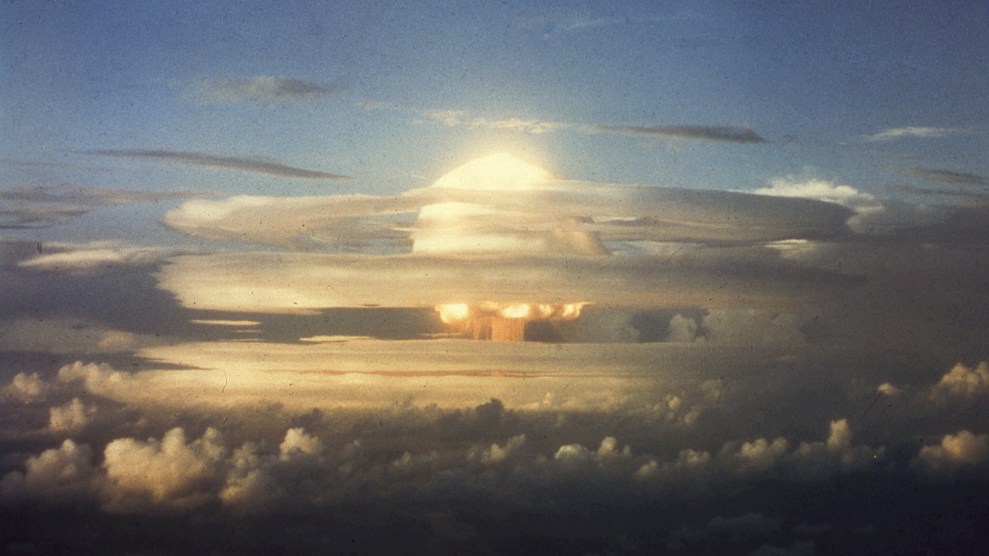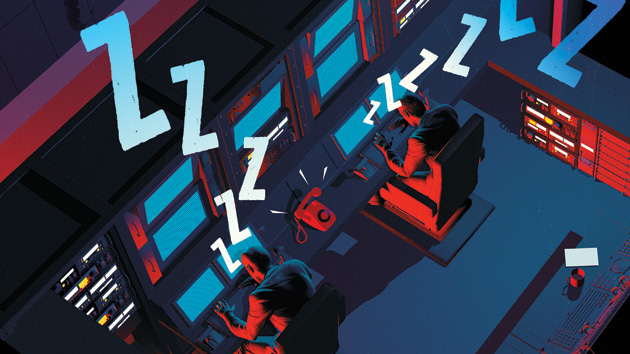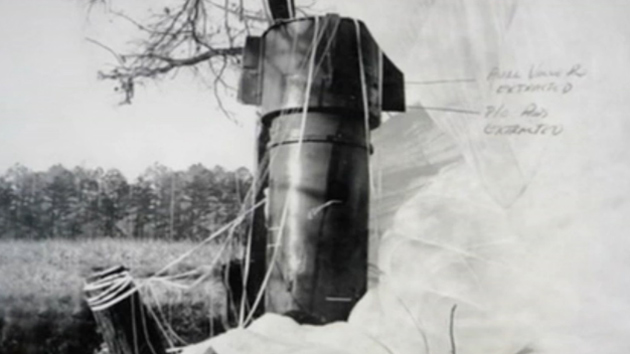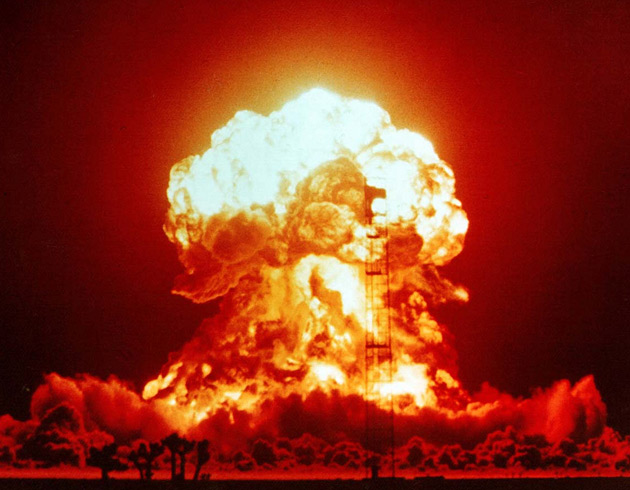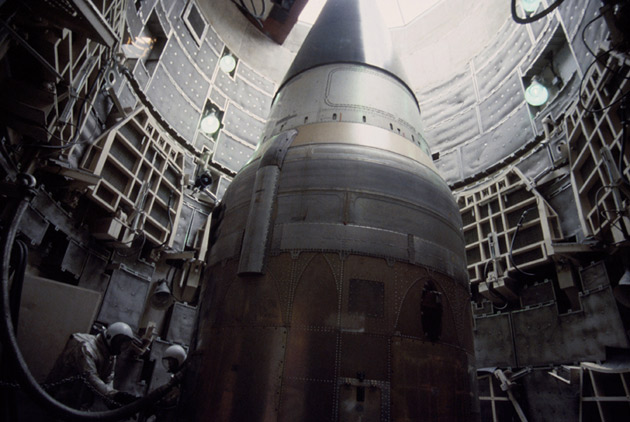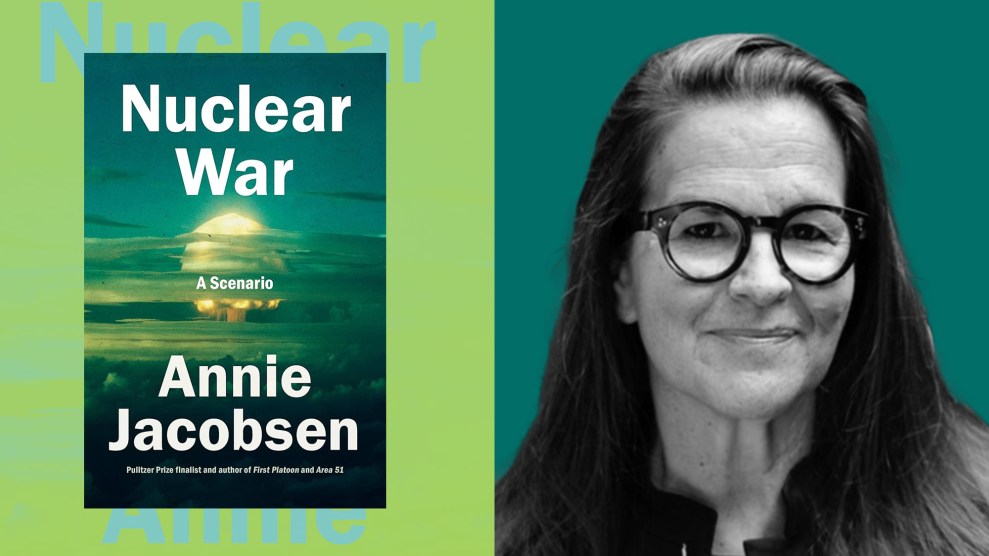
Mother Jones illustration; photo by Hilary Jones
Nuclear war is a topic few care to think about. We sometimes call it unthinkable. But we need to think carefully, and to talk—particularly with high-ranking foreign officials whose motives we may have reason to distrust, just as they distrust ours—about how we can collectively avoid launching a weapon that would end our civilization.
Pulitzer Prize finalist Annie Jacobsen’s timely new book, Nuclear War: A Scenario, is a lightning-fast read intended to put the nuclear threat squarely back on everyone’s radar. Her narrative thread, as the title suggests, is a fact-based (though thankfully fictional) scenario that shows how a nuclear launch can escalate into World War III at dizzying speed.
Jacobsen tees up her cinematic approach with chapters describing how we got here, including a discussion of America’s Single Integrated Operational Plan (SIOP) for General Nuclear War—which was devised in the 1960s and, as Jacobsen details in this Mother Jones book excerpt, was more or less a recipe for the end of the world.
Because that’s nuclear war: One bad assumption, one shot, one retaliation, and it’s unstoppable.
Your book is frightful. What made you want to write in such detail how a nuclear war could unfold?
As a national security reporter, I have written six previous books on military and intelligence programs—CIA, Pentagon, DARPA—all designed to prevent nuclear World War III. During the Trump administration, amid the “fire and fury” rhetoric, I was watching STRATCOM commanders and deputy commanders speak freely on C-SPAN about the dangers therein. I began to wonder, My god, what would happen if deterrence failed? I began to interview people during Covid, when people had more time on their hands for someone like me—and that began the terrifying process of learning that nuclear war is, in essence, a sequence of events, and that once it starts it almost certainly will not stop.
The US public hasn’t thought a whole lot about nuclear weapons since the Cold War. We have more nuclear nations today, but far fewer weapons in the global arsenal. Are we safer now?
Well, as I show in the book, it doesn’t take but one weapon to set off a chain reaction to unleash the current arsenal, which is forward deployed in launch-on-warning positions and could be fired in as little as a minute—15 minutes for the submarines. There are enough weapons in those positions right now to bring on a nuclear winter that would kill an estimated 5 billion people.
Are there too many? Absolutely. Have we made progress? The all-time high in 1986 was 70,481 nuclear weapons. Now, there are approximately 12,500. But to your point, there are nine nuclear-armed nations, not just two or three superpowers. And that presents a lot of unknowns that create serious unease and room for catastrophe.
So we may be less safe because we don’t really know how certain nations might behave—notably North Korea.
Absolutely. Reporting and writing this book was one surprise after another. For example, I did not know until I had it confirmed with US nuclear experts that North Korea does not announce any of its missile tests, whereas the other countries do. North Korea has launched 100 missiles since January 2022. After you read my book, you realize what happens to the US nuclear command and control apparatus in the seconds and minutes after a launch is seen by the advanced super satellite system we have. You can now imagine what goes on in those command centers.
A total frenzy.
Imagine!
One thing that really struck me is the unbelievable speed at which nuclear war is waged.
Gen. Robert Kehler, the former commander of STRATCOM, said to me that the world could end in the next couple of hours. It took me a minute to ask my next question, because coming from someone in that position of authority—the most significant role in the entire nuclear apparatus—that really blew my mind.
Ditto goes for an interview I did with President Barack Obama’s FEMA chief, Craig Fugate. Of course, FEMA is the agency in charge of what’s called population protection planning for American citizens in the event of hurricanes, floods, earthquakes. Fugate told me that after a nuclear war, there wouldn’t be any population protection planning because everyone would be dead.
Help is not coming.
I said, “Well, what should people do?” He more or less said, “Self-survive, and don’t forget your morals, and I hope you stocked Pedialyte”—because radiation poisoning makes you vomit and have diarrhea and away go all of your electrolytes, which leads to secondary problems.
I learned from your book that FEMA plays a unique role in the event of a nuclear attack, and it’s not what one might expect.
That’s right. In the ’50s and ’60s, the US position was that a nuclear war could be fought and won. That is no longer the official position. But plans were put in place for the continuity of government programs—the idea that the government must continue functioning no matter what. That is also a fantasy.
To hear from former Secretary of Defense Bill Perry about the madness and mayhem and anarchy that would follow, in his mind, in the event of a nuclear war, you really get the sense that civilization will fail. I believe one of the reasons so many of these sources went on the record for me is because they know that this is the truth. And they know it is up to the people to change the trajectory of where we’re headed. I mean, my god, look at the saber-rattling going on as we do this interview.
Potential nuclear nightmares range from an accidental detonation to a massive “decapitation” strike to someone using a small nuke on the battlefield. You picked the madman scenario: North Korea inexplicably launches a long-range missile at Washington, DC. Why that one?
I did a series of interviews with [physicist] Richard Garwin, who is now 95. He is arguably the most knowledgeable person about nuclear weapons on the planet, and he probably knows more about policy over the long lens of history because he was 23 or 24 years old when he designed the first thermonuclear bomb.
In the “Ivy Mike” test, it exploded with 10.4 megatons of power—about 1,000 Hiroshimas. Garwin said to me that his biggest fear was now, and always had been, the madman theory you referred to. He used the French phrase Après moi, le déluge—after me, the flood—referring to this idea that a maniacal, egotistical, narcissistic madman leader could launch a nuclear weapon for reasons no one would ever know.
And to counterattack North Korea, as in your scenario, the US would need to send missiles over Russia, which has a very unreliable early warning system.
That’s right. Learning about the technological limitations of some of the Russian systems was just as terrifying as any part of reporting this book.
It’s almost like you’d want to reach out to the Russians and say, look, just take our technology so you won’t launch on a false alarm—but the US would never do that.
There have been many opportunities to have a dialogue with the Russians—Putin inquired about joining NATO back during the Clinton administration. One really has to lean upon one’s leaders to think about communicating rather than saber-rattling, because I hope that my book demonstrates in appalling detail how horrific nuclear war would be. And we know from the Proud Prophet war games that no matter how it begins, it ends in nuclear apocalypse.
For context, Proud Prophet was a classified series of war games President Ronald Reagan ordered in 1983. Civilian and military planners convened for two weeks to run through scenarios that could spark a nuclear war and see how they played out.
That Proud Prophet was declassified is interesting. Nuclear war games are among the government’s most jealously guarded secrets. I printed a copy of what a couple pages of the declassified war game look like—95 percent is redacted. It’s literally a couple of headers and a few numbers.
But when something like that gets declassified, it becomes very valuable to the people. An individual like Paul Bracken—a civilian professor at Yale who participated in Proud Prophet—can now speak about it in general terms. He wrote in his own book that everyone left very depressed, because no matter how the nuclear scenario begins—if NATO is involved or not involved, China is involved or not—it always ends the same way, the most terrible way, because America has a “launch on warning” policy.
We do not wait to absorb a nuclear blow. Once a missile is on the way and there is secondary confirmation from ground radar, the president is asked to launch a counterstrike. In the book—I have the president asking this because it came up in my discussions with sources—he says, “How do we know it’s a nuclear weapon?”
And we don’t.
That is a fact. The answer is, Well, it could be a biological weapon. Another answer I was told is that no one launches a ballistic missile at the United States unless they’re expecting a counterattack. So now you are looping into the Orwellian world of: This is deterrence. Deterrence will hold. Don’t you dare launch at us or else! Which becomes part and parcel for why the counterattack is required, per the deterrence doctrine. There is no room for saying, well, maybe we’ll wait and see.
Once you break deterrence, everything else goes out the window.
Correct. One of the most haunting quotes in the book is from the deputy commander of STRATCOM, Lt. Gen. Tom Bussiere. I located an unclassified discussion he had with insiders, and the quote is along the lines of, When deterrence fails, it all unravels. In seconds and minutes and hours—not days and weeks and months.
Twelve thousand years of civilization extinguished in a few hours.
General Kehler was not speaking hyperbolically when he said that.
Say more about “launch on warning.” You cite Paul Nitze, a former defense secretary and later presidential adviser, calling the policy “inexcusably dangerous.” Presidents Bush, Obama, and Biden wanted it scrapped. So why is it still in place?
I’d like to shout out William Burr, who runs the Nuclear Documentation Project at the National Security Archive at George Washington University, because many of those quotes and documents come from that organization, which made them accessible to journalists like me. Nitze was one of the biggest hawks across the Cold War. To have a guy like that go on the record and say this is inexcusably dangerous says a lot.
Multiple presidents have campaigned on the promise that they will change this dangerous policy, but then they become president and you never hear of it again. That speaks to the kind of secret-keeping that is dangerous and can be changed. I wrote Nuclear War: A Scenario for the layperson to be able to rip through it in a night, no matter how terrifying. I do not bog the reader down with polemics or jargon, because this is an issue everybody should know about. Because only in knowing about it is change possible. We can look to The Day After battle, what’s known in inner circles as the Reagan Reversal policy of 1983.
Wait, what’s that?
So in 1983—I’m dating myself here—I was a high school student. And I watched the ABC movie The Day After.
I was the same age, and watching it too.
It’s a fictional account of a nuclear war between America and Soviet Russia, and half the country watched it. Interestingly, behind the scenes, ABC got a lot of pressure not to air it. Well, one very important American watched it: Reagan had a private screening at Camp David. His chief of staff tried to suggest that he shouldn’t watch it, but he did. And he wrote in his diary that he became “greatly depressed,” and he picked up the phone and called [then–Soviet President Mikhail] Gorbachev, and the two leaders communicated—which is really the only solution for any of this.
Because of those communications and because of their conference and because of the treaty, the insane nuclear arsenal has been reduced to the approximately 12,500 we have now, which is a considerable reduction. The president’s position prior to seeing The Day After was a much harder, more saber-rattling approach. He changed his position and became much more dovish.
“Launch on warning” puts extraordinary pressure on a president. The one in your scenario is pretty clueless. He hasn’t ever rehearsed. Nobody told him he’d have just six minutes to choose from a Denny’s breakfast menu of existential options in response to what may or may not be an incoming nuke. It’s hard to believe the Pentagon doesn’t put every new president through a series of war games.
I was just as surprised as you are. But that’s coming from multiple secretaries of defense and national security advisers—people in a position to advise the president on a nuclear counterattack. The best summation came from Leon Panetta, who explained that as White House chief of staff he was witness to the fact that the president is primarily concerned with domestic issues—like his popularity. I asked Panetta how clued in he was when he was the CIA director, and he said almost not at all, because the CIA is about intelligence, not nuclear operations.
Only when he became secretary of defense did it really hit home, the weight of all of this. He spoke about visiting missile silos, submarine bases, and nuclear command bunkers—once you go to places like that, your entire perspective changes. And that is why I believe he was willing to go on the record. You really get the sense that things are precarious once they begin, and decisions follow that are out of everyone’s control.
Right. And our continued existence depends not only on our internal communications and processes, but those of our adversaries, about which we know little.
Absolutely.
Your book busts some common myths, for instance the belief that the US could shoot down an incoming nuclear missile. We really can’t defend against nuclear weapons, can we?
We can’t. That is pure fantasy. During the final fact-checking incantations, I had the book read by a lieutenant general who ran these scenarios for NORAD. I was almost hoping someone would say, Annie, you should take this part out of the book, because we have a secret Iron Dome that you can’t report on. No. The truth is that the United States relies upon 44 interceptor missiles to stop any incoming missiles. Russia alone has 1,674 nuclear warheads in “ready to launch” position. Adding to that, according to congressional reports, the interceptors are only approximately 50 percent effective.
Under the best of circumstances.
Absolutely, like when you’re doing a test and you know precisely where the missile is going to be. It’s a curated test. So people have this idea that we have an Iron Dome–type shield. And we don’t.
The Reagan Reversal bit reminds me of a moment from your scenario. Your secretary of defense is sworn in as president because the president and others in the line of succession are dead or AWOL, and he has this moment of humanity. Russia has launched all its ICBMs at us, so we know we’re goners. And the new guy asks: Why respond now if all it will do is kill millions more people? The STRATCOM commander is like, Nope, we’re doing this. Humanity is already doomed, yet Russia and the United States keep launching their weapons until practically none are left. It’s nonsensical. But is it realistic?
It is if you talk to the sources I spoke to. A lot of the decision-tree situations involving the defense secretary came from my multiple discussions with former Secretary of Defense Bill Perry, who has thought a lot about this—and what an individual’s thought process would be. The point of including that question was to demonstrate how the madness of MAD—mutual assured destruction—takes over.
I asked [retired weapons engineer] Glen McDuff—the curator of the classified museum at the Los Alamos National Laboratory—the question you’re kind of asking me: What did he think, as an insider, about the notion that people would not follow orders? He basically said: Annie, I would suggest betting on Powerball, because you’d have a better chance of winning than betting on a high-ranking individual in the nuclear command and control system not following orders.
Right. It seems like folks in the nuclear command and control structure have rehearsed these scenarios over and over. They’re on autopilot to a degree. Which gets at the notion of “apes on a treadmill” that you write about late in the book: We’ve made this plan, and we’re going to follow it—even if it’s completely bonkers.
Apes on the treadmill was just such a brilliant concept. It goes back to the Cold War when it was used as a metaphor for people slavishly following away in this nuclear arms race.
But even more interesting was the present-day anecdote I found. It was a scientific experiment having nothing to do with the original metaphor but was literally apes on a treadmill. The researchers were studying bipedalism: They put humans on the treadmill and they put apes on the treadmill. Anecdotally, one of the scientists said, and I’m paraphrasing, that some of the apes got fed up with walking to nowhere and got off the treadmill.
I thought, my god, the apes are smarter than the humans when it comes to mutual assured destruction.

